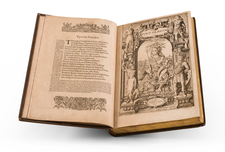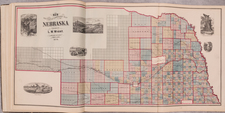The 1627 First Edition of the First World Atlas Published by An Englishman.
Folio. Letterpress title and contents leaf, 22 double-page engraved maps, text leaves for Bermuda and "A Briefe Description of the Ciuill VVarres..." (complete). Expertly rebound to style in full calf, centerpiece and corner arabesques tooled in gilt.
Speed's Prospect is not only the first world atlas by an Englishman but also the most famous. We can only trace one other copy of the 1627 first edition on the market in the last 50 years: the Lord Wardington Copy (lot 484), which made £90,000 ($177,300 at the time of the Wardington Sale).
Wardington concluded that the 1627 Prospect was first issued as a separate atlas (as here), not accompanied by Speed's Theatre:
As the title states, it was to be accompanied by a copy of the Theatre. However, I think it was issued separately here and the Theatre to go with it was a hastily re-printed version of the 1616 (1623) edition with the general title-page altered to 1627 and the type reset. This edition of the Theatre was not large and was again reprinted to accompany the 1631 edition. The prospect was reprinted no less than twelve times in the 50 years to 1676, the date of the last edition.
We concur with this finding; the present atlas bears no evidence that it was bound with the Theatre.
Contents
The atlas includes the following maps:
- A New and Accurat Map of the World Drawne according to ye truest Descriptions latest Discoveries & best Observations yt have beene made by English or Strangers.
- Asia with the Islands adioyning described, the atire of the people, & Townes of importance all of them newly augmented by I. S.
- Africae, described the manners of their Habits, and buildinge: newly done into English by I.S.
- Europ, and the cheife-Cities contayned therin, described: with the habits of most Kingdoms now in use.
- America with those known parts in that unkowne worlde both people and manner of buildings Discribed and inlarged
- Ελλάς | Greece
- A New Mappe of the Romane Empire newly described by John Speede
- A. Newe Mape of Germany Newly Augmented by John Speed.
- Bohemia Newly described by John Speed
- France revised and augmented, the attires of the French and Situations of their chiefest cityes observed by John. Speede.
- A New Mape of Ye XVII Provinces of Low Germanie, mended a new in manie places.
- Spaine Newly described, with many adictions, both in the attires of the people & the Situations of their cheifest Cityes.
- Italia Newly augmented by I. Speede
- The Mape of Hungari newly augmented by John. Speede
- The Kingdome of Denmarke augmented by John Speede
- A Newe. Mape of Poland
- The Kingdome of Persia with the cheef Citties and Habites described.
- The Turkish Empire. Newly Augmented by John Speed 1626.
- the Kingdome of China newly augmented by I.S.
- A Newe Mape of Tartary augmented by John Speede and are to be sold in pops head Alley by George Humble.
- Mappa Aestivarum | A Mapp of the Sommer Islands
- The Invasions of England and Ireland With al their Ciuill Wars Since the Conquest.
John Speed (1551 or '52 - 28 July 1629) was the best known English mapmaker of the Stuart period. Speed came to mapmaking late in life, producing his first maps in the 1590s and entering the trade in earnest when he was almost 60 years old.
John Speed's fame, which continues to this day, lies with two atlases, The Theatre of the Empire of Great Britaine (first published 1612), and the Prospect of the Most Famous Parts of the World (1627). While The Theatre ... started as solely a county atlas, it grew into an impressive world atlas with the inclusion of the Prospect in 1627. The plates for the atlas passed through many hands in the 17th century, and the book finally reached its apotheosis in 1676 when it was published by Thomas Bassett and Richard Chiswell, with a number of important maps added for the first time.













![Theatrum Orbis Terrarum [with:] Parergon, Sive Veteris Geographiae Aliquot Tabulae [and:] Nomenclator](https://storage.googleapis.com/raremaps/img/small/92703.jpg)
![[ Atlas - Florida and Southern Canal Projects ] Travaux d'améliorations intérieurs projetés ou exécutés par le gouvernement général des États-Unis d'Amérique, de 1824 à 1831 [complete with:] Travaux d'améliorations intérieurs projetés ou exécutés... Atlas.](https://storage.googleapis.com/raremaps/img/small/85067.jpg)
![Geographia Universalis, Vetus et Nova, Complectens Claudii Ptolemaei Alexandrini Enarrationis Libros VIII. [Universal Geography, Ancient and Modern, comprising the eight books of the Commentary by Claudius Ptolemy of Alexandria.]](https://storage.googleapis.com/raremaps/img/small/94373.jpg)
